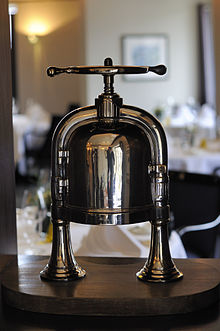Pressed duck


Pressed duck (French: canard à la presse, caneton à la presse, canard à la rouennaise, caneton à la rouennaise or canard au sang) is a traditional French dish. The complex dish is a specialty of Rouen and its creation attributed to an innkeeper from the city of Duclair.[1] Since the 19th century,[2] it has also been a specialty of the Tour d'Argent restaurant in Paris where it is formally known as the Caneton Tour d'Argent (Tour d'Argent duckling). It consists of various parts of a duck served in a sauce of its blood and bone marrow, which is extracted by way of a press. It has been considered "the height of elegance."[3]
Preparation
[edit]First, a duck (preferably young and plump)[4] is asphyxiated to retain the blood. The duck is then partially roasted. Its liver is ground and seasoned, then the legs and breast are removed.

The remaining carcass (including other meat, bones, and skin) is then put in a specially-designed press, similar to a wine press. Duck presses tend to be substantial and heavy pieces of equipment, generally made of solid brass or iron.[5][6] Pressure is then applied to extract duck blood and other juices from the carcass. The extract is thickened and flavoured with the duck's liver, butter, and cognac, and then combined with the breast to finish cooking.
Sauce
[edit]Other ingredients that may be added to the sauce include foie gras, port wine, Madeira wine, and lemon. The breast is sliced and served with the sauce in a first serving; the legs are grilled and served as the next course.[7]
See also
[edit]References
[edit]- ^ "Le canard à la rouennaise ou canard au sang". Rouentourisme.com.
- ^ "Frédéric Delair and the Numbered Duck". La Tour d'Argent -- history. Archived from the original on 17 January 2013. Retrieved 12 January 2013.
- ^ "Pressed Duck a la Tour d'Argent," in Tennant, Jr., S.G.B. (1999). Ducks & Geese. Willow Creek Press. p. 26. ISBN 978-1-57223-202-0.
- ^ Tennant, Ducks & Geese, 26.
- ^ "The History Of The Recipe For Use With A Duck Press". Cuisonology.com.
- ^ "The Duck Press: A French Classic". Center of the Plate. 12 September 2014.
- ^ "Pressed Duck a la Tour d'Argent," in Peterson, James (2002). Glorious French food: a fresh approach to the classics. John Wiley and Sons. p. 394. ISBN 978-0-471-44276-9.
Text is available under the CC BY-SA 4.0 license; additional terms may apply.
Images, videos and audio are available under their respective licenses.
